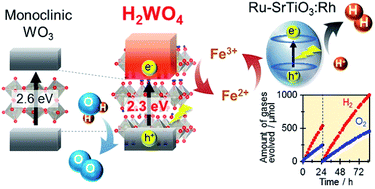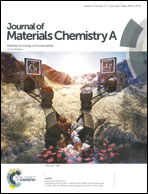Tungstic acids H2WO4 and H4WO5 as stable photocatalysts for water oxidation under visible light†
Abstract
The development of new photocatalytic materials that can stably reduce and/or oxidize water by harvesting a wider range of visible light is indispensable to achieve high practical efficiency in artificial photosynthesis. Although we have recently found that tungstic acid monohydrate (H2WO4) can stably oxidize water to O2 by harvesting a wider range of visible light (∼500 nm) than WO3 (∼460 nm), the origin of its narrower bandgap has not been clarified. Herein, we studied H2WO4 in detail, along with the analogous tungstic acid dihydrate (H4WO5), especially focusing on their band structures and their photocatalytic activities for water oxidation in the presence of different electron acceptors (Ag+ and Fe3+). It was revealed that the conduction band minimum (CBM) of H2WO4 is considerably lower than that of conventional monoclinic WO3, whereas both the band gap and level of H4WO5 are similar to those of WO3. The lower CBM of H2WO4 can probably be explained by a more dispersed conduction band caused by greater orbital overlap between W-5d and O-2p orbitals than in monoclinic WO3. Both tungstic acids stably generate O2 from aqueous solutions containing Fe3+ corresponding to each of their photoabsorption properties (∼460 and ∼500 nm), while they showed negligible activity from sacrificial electron acceptor Ag+. Visible-light-driven Z-scheme water splitting proceeded using both tungstic acids as O2-evolving photocatalysts.



 Please wait while we load your content...
Please wait while we load your content...